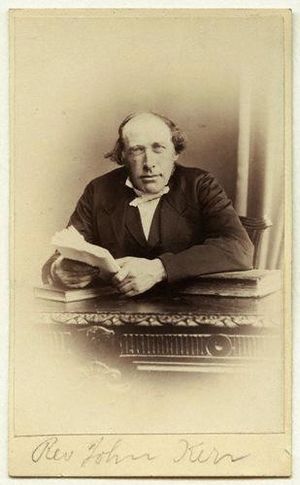John Kerr (physicist) facts for kids
Quick facts for kids
John Kerr (physicist)
|
|
|---|---|

John Kerr, c. 1860, photograph by Thomas Annan
|
|
| Born | 17 December 1824 Ardrossan, Scotland
|
| Died | 15 August 1907 (aged 82) Glasgow, Scotland
|
| Known for | Kerr effect |
John Kerr was a Scottish physicist who lived from 1824 to 1907. He was a very important scientist who studied how light and electricity interact. He is best known for discovering something called the Kerr effect. This discovery helped scientists understand more about light and led to new technologies.
Contents
Who Was John Kerr?
John Kerr was born on December 17, 1824, in a town called Ardrossan in Scotland. He went to school in Glasgow from 1841 to 1846. Later, he also studied in Edinburgh.
In 1857, John Kerr became a teacher of mathematics. He taught at the Free Church Training College in Glasgow. He continued his important scientific work throughout his life. John Kerr passed away in Glasgow in 1907.
Discovering the Kerr Effect
John Kerr's most famous discovery happened in 1875. He found that certain materials, like special liquids or solids, could change how light passes through them when an electric field was present. This change is known as the Kerr effect.
How the Kerr Effect Works
Imagine light traveling through a material. Normally, light travels at the same speed in all directions within that material. But with the Kerr effect, if you apply an electric field to the material, light can behave differently.
The material acts like it has two different refractive indexes. This means light rays can bend differently depending on their direction. The stronger the electric field, the more the light changes. This effect is also called electric double refraction.
John Kerr also found a similar effect when a magnetic field was used instead of an electric field. This is known as the magneto-optic Kerr effect.
The AC Kerr Effect
Today, powerful lasers can create their own strong electric fields. This means the light from the laser itself can cause the Kerr effect in a material. This version is called the AC Kerr effect.
Using the Kerr Effect
The Kerr effect is not just a cool scientific discovery. It has been used in many practical ways!
The Kerr Cell
One important invention based on the Kerr effect is the Kerr cell. This device uses the Kerr effect to control light very quickly.
- High-speed photography: Kerr cells can act like super-fast camera shutters. They can open and close in as little as 100 nanoseconds (that's 100 billionths of a second!). This allows photographers to capture incredibly fast events.
- Measuring the speed of light: In 1928, scientists used a Kerr cell to measure the speed of light more accurately. Before this, mechanical devices were used, but the Kerr cell allowed for much faster changes in the light beam. This led to more precise measurements of how fast light travels.
Early Kerr cells used a block of glass. Today, they often use liquids like nitrobenzene because these liquids show the Kerr effect very well.
Other Contributions
Besides his work on light and electricity, John Kerr also supported the metric system in the United Kingdom. The metric system is a way of measuring things using units like meters and kilograms, which are used by most countries around the world.
Honours and Awards
John Kerr received several important awards and recognitions for his scientific work:
- In 1864, he received an honorary degree (LL.D) from the University of Glasgow.
- In 1890, he became a Fellow of the Royal Society. This is a very prestigious group of top scientists.
- In 1898, he was awarded the Royal Medal by the Royal Society, one of their highest honours.
- In 1902, he received a pension from the Civil List, which is a payment from the government for important public service.

